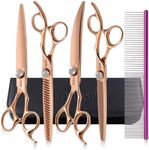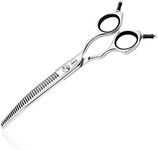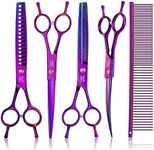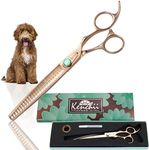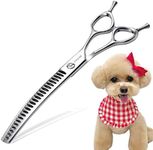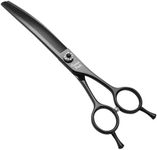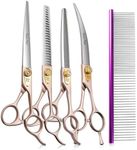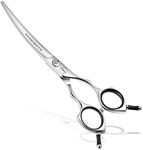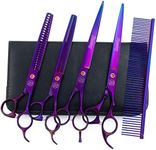Buying Guide for the Best Dog Grooming Scissors
Choosing the right dog grooming scissors is important for both your pet’s comfort and your grooming results. The right pair will make grooming easier, safer, and more enjoyable for both you and your dog. When shopping, think about your dog’s coat type, your experience level, and the specific grooming tasks you want to accomplish. Understanding the key features of grooming scissors will help you make a choice that fits your needs and keeps your dog looking and feeling their best.Blade TypeBlade type refers to the shape and edge of the scissor blades. The most common types are straight, curved, and thinning (or blending) scissors. Straight blades are great for general trimming and creating straight lines, while curved blades help with shaping around the head, paws, and other rounded areas. Thinning scissors are used to blend and remove bulk from thick coats. Choosing the right blade type depends on the areas you plan to groom and the finish you want. If you’re new to grooming, starting with a straight and a curved pair covers most needs, while thinning scissors are helpful for dogs with thick or double coats.
Blade LengthBlade length is the measurement from the tip to the pivot of the scissors. Shorter blades (around 4-5 inches) offer more control and are ideal for small dogs or detailed work like trimming around the face and paws. Longer blades (6-7 inches or more) are better for larger dogs or for making long, smooth cuts along the body. To pick the right length, consider the size of your dog and the areas you’ll be grooming most often. If you have a small dog or need precision, go shorter; for bigger dogs or faster body trims, go longer.
Handle DesignHandle design affects comfort and control during grooming. There are basic straight handles, offset handles (where one handle is slightly shorter), and ergonomic or swivel designs that reduce hand fatigue. If you plan to groom often or for long periods, ergonomic handles can make a big difference in comfort. For occasional use, a standard handle may be fine. Try to choose a handle that feels comfortable in your hand and allows you to maneuver easily.
Material and SharpnessThe material and sharpness of the blades determine how well the scissors cut and how long they last. Stainless steel is the most common material, offering a good balance of sharpness, durability, and rust resistance. High-quality steel stays sharp longer and provides smoother cuts, which is important for your dog’s comfort and safety. If you have a thick-coated dog, sharper, higher-quality blades are especially important to avoid pulling or snagging. For most home groomers, stainless steel is a reliable choice.
Safety FeaturesSafety features like rounded tips help prevent accidental pokes or cuts, especially when trimming sensitive areas like the face, ears, or paws. If you’re new to grooming or have a wiggly dog, rounded tips are a smart choice. Some scissors also have finger rests or adjustable tension screws for added control and comfort. Consider these features if you want extra peace of mind or plan to groom regularly.
Weight and BalanceThe weight and balance of the scissors affect how easy they are to use, especially during longer grooming sessions. Lighter scissors are easier to handle and reduce hand fatigue, while well-balanced scissors feel stable and controlled in your hand. If you have smaller hands or plan to groom for extended periods, look for lighter, well-balanced scissors. Try holding the scissors before buying if possible to see how they feel.

